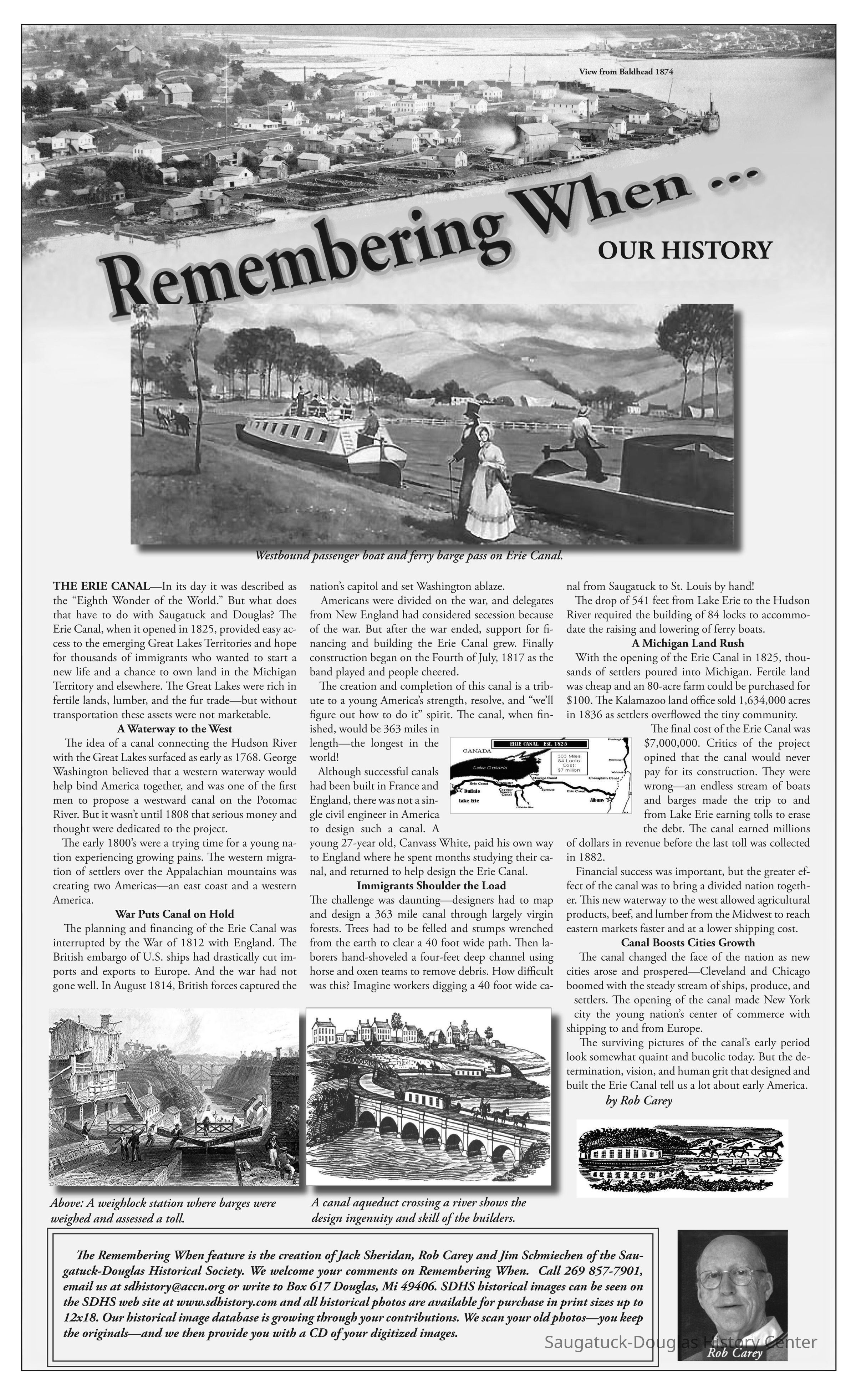Erie Canal

2021.87.74
THE ERIE CANAL-In its day it was described as the "Eighth Wonder of the World." But what does that have to do with Saugatuck and Douglas? The Erie Canal, when it opened in 1825, provided easy access to the emerging Great Lakes Territories and hope for thousands of immigrants who wanted to start a new life and a chance to own land in the Michigan Territory and elsewhere. The Great Lakes were rich in fertile lands, lumber, and the fur trade-but without transportation these assets were not marketable. A Waterway to the West The idea of a canal connecting the Hudson River with the Great Lakes surfaced as early as 1768. George Washington believed that a western waterway would help bind America together, and was one of the first men to propose a westward canal on the Potomac River. But it wasn't until 1808 that serious money and thought were dedicated to the project. The early 1800's were a trying time for a young nation experiencing growing pains. The western migration of settlers over the Appalachian mountains was creating two Americas-an east coast and a western America. War Puts Canal on Hold The planning and financing of the Erie Canal was interrupted by the War of 1812 with England. The British embargo of U.S. ships had drastically cut imports and exports to Europe. And the war had not gone well. In August 1814, British forces captured the nation's capitol and set Washington ablaze. Americans were divided on the war, and delegates from New England had considered secession because of the war. But after the war ended, support for financing and building the Erie Canal grew. Finally construction began on the Fourth of July, 1817 as the band played and people cheered. The creation and completion of this canal is a tribute to a young America's strength, resolve, and "we'll figure out how to do it" spirit. The canal, when finished, would be 363 miles in length-the longest in the world! Although successful canals had been built in France and England, there was not a single civil engineer in America to design such a canal. A young 27-year old, Canvass White, paid his own way to England where he spent months studying their canal, and returned to help design the Erie Canal. Immigrants Shoulder the Load The challenge was daunting-designers had to map and design a 363 mile canal through largely virgin forests. Trees had to be felled and stumps wrenched from the earth to dear a 40 foot wide path. Then laborers hand-shoveled a four-feet deep channel using horse and oxen teams to remove debris. How difficult was this? Imagine workers digging a 40 foot wide canal from Saugatuck to St. Louis by hand! The drop of 541 feet from Lake Erie to the Hudson River required the building of 84 locks to accommodate the raising and lowering of ferry boats. A Michigan Land Rush With the opening of the Erie Canal in 1825, thousands of settlers poured into Michigan. Fertile land was cheap and an 80-acre farm could be purchased for $100. The Kalamazoo land office sold 1,634,000 acres in 1836 as settlers overflowed the tiny community. The final cost of the Erie Canal was $7,000,000. Critics of the project opined that the canal would never pay for its construction. They were wrong-an endless stream of boats and barges made the trip to and from Lake Erie earning tolls to erase the debt. The canal earned millions of dollars in revenue before the last toll was collected in 1882. Financial success was important, but the greater effect of the canal was to bring a divided nation together. This new waterway to the west allowed agricultural products, beef, and lumber from the Midwest to reach eastern markets faster and at a lower shipping cost. Canal Boosts Cities Growth The canal changed the face of the nation as new cities arose and prospered-Cleveland and Chicago boomed with the steady stream of ships, produce, and settlers. The opening of the canal made New York city the young nation's center of commerce with shipping to and from Europe. The surviving pictures of the canal's early period look somewhat quaint and bucolic today. But the determination, vision, and human grit that designed and built the Erie Canal tell us a lot about early America. by Rob Carey
Remembering When
Winthers, Sally
2021.87
Sheridan, John "Jack" O. 1938-
Donation
Digital data in CatalogIt
Carey, Rob 1928-2019Sheridan, John "Jack" O. 1938-Schmiechen, James A.
Local Observer
01/01/2022
11/18/2023
